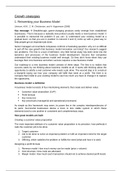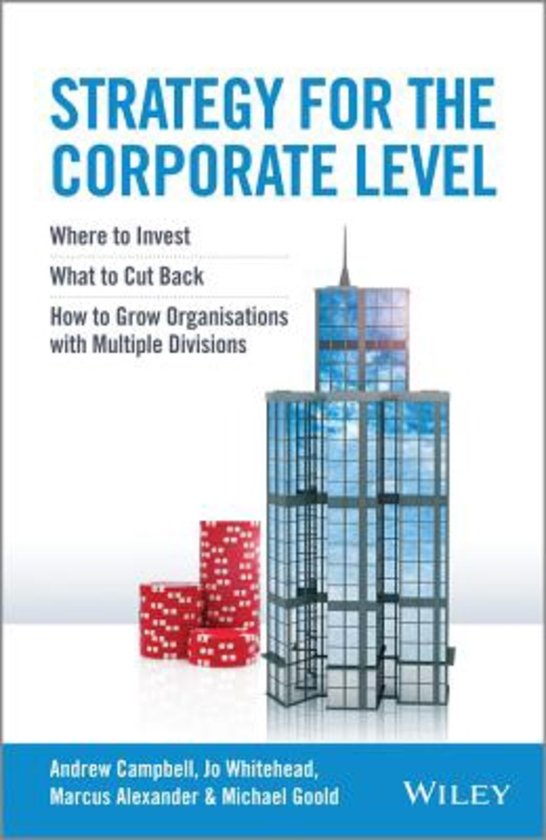Growth strategies
1. Reinventing your Business Model
Johnson, M.W., C. M. Christensen, and H. Kagermann (2008)
Key message Breakthrough, game-changing products rarely emerge from established
businesses. That is because a radically new product usually needs a new business model. It
is possible to transcend the problem if you can: 1) understand your existing model at a
gradual level, so that you are in position to reinvent it and 2) come up with a great way to
help people get an important job done.
Senior managers at incumbent companies confront a frustrating question: why is it so difficult
to pull off the new growth that business model innovation can bring? Our research suggest
two problems. The first is a lack of definition: very little formal study has been done into the
dynamics and processes of the business model development. Second, few companies
understand their existing business model well enough. So they don’t know when they can
leverage their core business and when success requires a new business model.
Our roadmap to a new business model consists of three steps. The first is to realize that
success starts by not thinking about business models at all. It starts with thinking about the
opportunity to satisfy a real customer who needs a job done. The second step is to construct
a blueprint laying out how your company will fulfill that need at a profit. The third is to
compare that model to your existing model to see how much you have to change it to capture
the opportunity.
Business model: a definition
A business model consists of four interlocking elements that create and deliver value:
Customer value proposition (CVP)
Profit formula
Key resources
Key processes (managerial and operational processes)
As simple as this framework may seem, its power lies in the complex interdependencies of
its parts. Successful businesses devise a more or less stable system in which these
elements bond to one another in consistent and complementary ways.
How great models are built
Creating a customer value proposition
The most important attribute of a customer value proposition is its precision: how perfectly it
nails the customer job to be done.
1. Target customer
2. Job to be done to solve an important problem or fulfil an important need for the target
customer
3. Offering, which satisfies the problem or fulfills the need (what and how it is sold)
Designing a profit formula
1. Revenue model. How much money can be made (price x volume)
2. Cost structure. How costs are allocated
3. Margin model. How much each transaction should net to achieve desired profit levels
, 4. Resource velocity. How quickly resources need to be used to support target volume
Identifying key resources and processes
1. Resources needed to deliver the customer value proposition (e.g. people, technology,
equipment, information, channels). Oftentimes it’s not the individual resources and
processes that make the difference but their relationship to one another.
2. Processes as well as rules, metrics and norms that make the profitable delivery of the
customer value position repeatable and scalable.
Companies will almost always need to integrate their key resources and processes in a
unique way to get a job done perfectly for a set of customers when they do, they almost
always create enduring competitive advantage.
Rules, norms and metrics are often the last element to emerge in a developing business
mode. They may not be fully envisioned until the new product or service has been road
tested. Nor should they be, business models need to have the flexibility to change in their
early years.
When a new business model is needed
There are clearly times when creating new growth requires venturing not only into unknown
market territory but also into unknown business model territory. When significant changes
are needed to all four elements of your editing model. We have observed five strategic
circumstances that often require business model change:
1. The opportunity to address through disruptive innovation the needs of large groups of
potential customers who are shut out of a market entirely because existing solutions
are too expensive or complicated (Tata’s Nano);
2. The opportunity to capitalize on a brand-new technology by wrapping a new business
model around it (Appel and MP3 players) or the opportunity to leverage a tested
technology by bringing it to a whole new market;
3. The opportunity to bring a job-to-be-done focus when one does not exist yet.;
4. The need to fend off low-end disrupters;
5. The need to respond to a shifting basis of competition.
2. Blue Ocean Strategy
Kim, W.C., & Mauborgne, R. (2004)
Key message the business universe consists of two distinct kinds of space, which we
think of as red and blue oceans. Red oceans represents all the industries in the existence
today – the known market space. In red oceans, industry boundaries are defined and
accepted. Companies try to outperform their rivals in order to grab a greater share of existing
demand. Blue oceans denote all the industries not in existence today – creating uncontested
market space that make competition irrelevant. Pulling in a whole new group of customers
who are traditionally noncustomers of the industry. There are two ways to create blue
oceans; give rise to completely new industries or creating from within a red ocean.
The paradox of strategy
Unfortunately, most companies seem becalmed in their red oceans. Part of the explanation is
that corporate strategy is heavily influenced by its roots in military strategy. It is all about
confronting an opponent and driving him off a battlefield of limited territory. Blue ocean
, strategy is about doing business where there is no competitor. It is about creating new land.
The tendency of corporate strategy to focus on winning against rivals was exacerbated by
the meteoric rise of Japanese companies in the 1970s and 1980s. As the competition
mounted in the global marketplace, a slew of read ocean strategies emerged, all arguing that
competition was at the core of corporate success and failure. Of course competition matters.
But by focusing on competition two very important scholars have be ignored; finding and
developing markets where there is little or no competition and exploiting and protecting blue
oceans.
Toward blue ocean strategy
Blue oceans are not about technology innovation. The underlying technology is often
already in existence;
Incumbents (existing players) often create blue oceans – and usually within their core
business. Blue oceans are often created from within red oceans of existing industries;
Company and industry are the wrong units of analysis. Most appropriate unit of
analysis is the strategic move – the set of managerial actions and decisions involved.
Creating blue oceans builds brands. A blue ocean strategic move can create brand
equity.
The defining characteristics
Red ocean strategy Blue ocean strategy
Compete in existing market space Create uncontested market space
Beat the competition Make the competition irrelevant. Don’t use
competition as a benchmark
Exploit existing demand Create and capture new demand
Make the value/cost trade-off Break the value/cost trade-off
Align the whole system of a company’s Align the whole system of a company’s
activities with its strategic choice of activities in pursuit of differentiation and low
differentiation or low cost cost (value increases for customer and
company)
The fundamental shift in the alignment of low cost and differentiation implies a fundamental
change in strategic mindset. Red oceans are based on environmental determinism
(structionist), by assuming that industry structural conditions are given. Blue ocean strategies
are based on the reconstructionist view, in which market boundaries and industries can be
reconstructed.
Barriers to imitation
Blue ocean strategy creates considerable economic and cognitive barriers to imitation. Blue
ocean creators immediately attract customers in large volumes, they are able to generate
scale economies very rapidly, putting would-be imitators at an immediate and continuing cost
disadvantage. Also, when a company offers a leap in value, rapidly earns brand buss and a
loyal following in the marketplace.
3. Technnological acquistions: The Impact of Geography on Post -
Acquisition Innovation Performance
McCarthy, K. and Aalbers, H.L. (2016)






